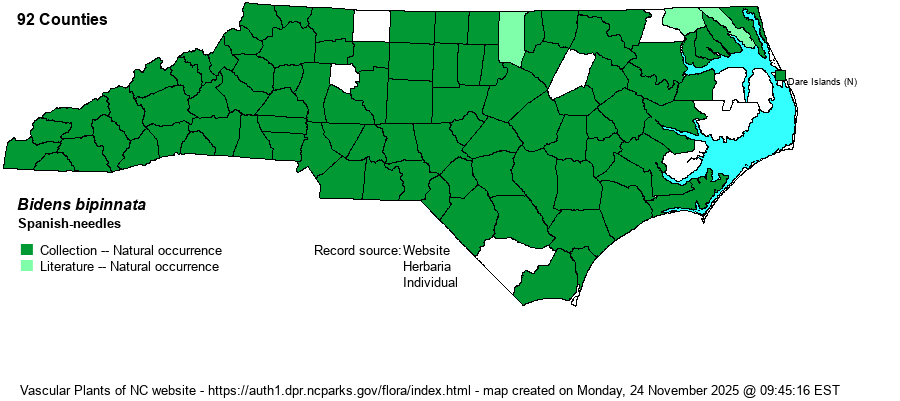| Author | L. | |
| Distribution | Throughout the state; scarce on the Pamlimarle Peninsula and on the Outer Banks.
MA to southern Ont., NE, and AZ, south to Mexico. | |
| Abundance | Common to very common over the state, except uncommon to infrequent along the Outer Banks and nearby mainland areas. | |
| Habitat | A wide variety of disturbed places, such as roadsides, fields, powerline clearings, croplands, yards, waste lots, and openings in floodplains. Shows an affinity to damp places but is not nearly as tied to wetlands as are many other similar species. | |
| Phenology | Flowering and fruiting July-October. | |
| Identification | Spanish-needles grows to 3-4 feet tall and is readily identified by its black, elongate, pronged fruits, 7-15 mm long. As in other beggarticks (Bidens spp.) the fruits are awned, in this case with 3-4 awns (vs. 2 in most of our species). Also unusual are the short (or absent) ray florets (vs. prominent in most our species). Thus, the flowers may appear to lack rays. The leaves are triangular in shape, with many divided segments as in most other Bidens. Most people are familiar with this weedy species by getting the numerous "barbs" stuck into their pants when brushing up against the plants. | |
| Taxonomic Comments | None
| |
| Other Common Name(s) | The common name is often if not usually written as Spanish Needles, without the hyphen. | |
| State Rank | S5 | |
| Global Rank | G5 | |
| State Status | | |
| US Status | | |
| USACE-agcp | FAC link |
| USACE-emp | FACU link |

